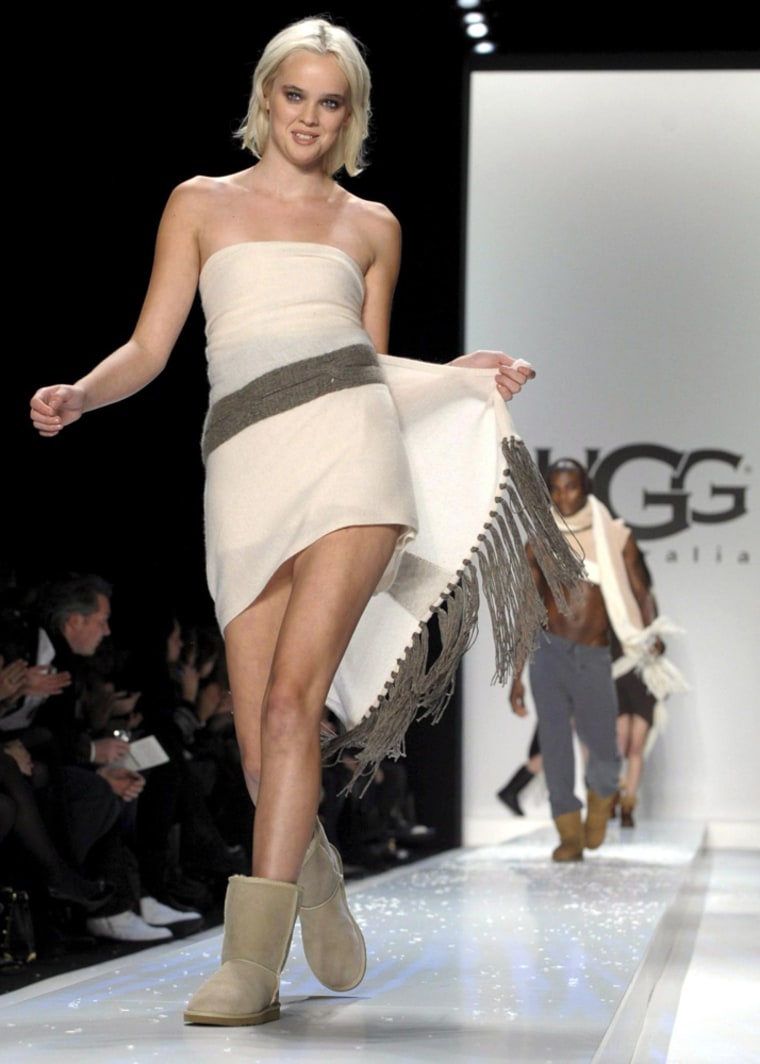It's gotten downright tough to sell a sole these days. For years, the luxury footwear market was buoyed by that paean of single-girl consumerism, "Sex and the City." Copycat Carries made household names of boutique brands like Manolo Blahnik and Jimmy Choo, and no heels — or prices — were too high. Of course, now we're suffering a financial hangover worse than the after-effects of any number of Cosmos. As Carrie might have asked her laptop: What happens to a relationship when one partner can't support the other anymore?
Most luxury shoe brands are privately held and keep their numbers close to the vest, but high-end department store numbers provide a reliable glimpse of the plot twist in this sartorial drama. High-end retailers Nordstrom, Neiman Marcus, and Saks all had double-digit drops in December, and analysts aren't cheerful about this year, either. According to consulting firm Bain & Co., the global market for luxury goods could fall as much as 7 percent. Aside from spending less, shoppers are choosing differently when they indulge. What are they buying? In a word, UGGs. If it seemed like those sheepskin baked potatoes were on everyone's feet last year, that's because they pretty much were, with sales growing a whopping 57 percent. Another winner in the battle for the hearts and heels of consumers was Merrell, a brand that specializes in glorified clogs. What's going on? It's as if we ditched Mr. Big for Seth Rogen.
Shoppers have shifted their top priority from looking good to feeling good, says Elaine Goldstein, chairwoman of the accessories design department at the Fashion Institute of Technology. Consumers want their purchases to make them feel good about themselves, whether the rationale behind the buy is "They're so comfortable I'll wear them everywhere" or "They're so well-made I'll keep them for years." We're not embracing ugly shoes exclusively, but even the super-rich are dialing back the flash factor. Conspicuous consumption is the new toxic bachelor.
The Big Money asked luxury and footwear analysts to break out the crystal ball and describe the sector in 2009, so we'll know what to expect when we pull on our UGGs to go shopping. Retailers and manufacturers are going to have their hands full reinventing their offerings to align with new consumer tastes — and budgets. But it's not all gloom and doom. Yes, we'll still have Patricia Fields for Payless and people who abuse Crocs by wearing them everywhere short of black-tie affairs, but there are a few bright spots.
Markdowns abound. Most gratifying for consumers, retailers are slashing prices to move product: albeit sometimes surreptitiously to avoid that whiff of fire-sale desperation. But snap up those sling-backs while you can; the deep cuts retailers are making now will lead to more limited selections down the road.
Salons shrink. According to Sam Poser, former footwear buyer and current vice president and senior research analyst for brokerage Sterne Agee, the shoe department at Saks or Bloomies is almost certain to be smaller come spring. Retail buyers are expected to take a much harder look at their mix and reduce their purchases. They might keep a full selection of one brand but pare another back to the bone, or they might choose to reduce the number of varieties they carry by designer. Shoppers are less likely to see swaths of real estate dedicated, shrinelike, to single brands.
Classic looks rule. Expect more classic shapes, fewer trendy flourishes, and less fanciful experimentation. One casualty, according to Kwesi Blair, senior associate at the luxury-market consulting firm Robert Burke Associates, will be shoes dripping with jewels, fur trim, feathers, or anything else that could be described by the word bling. These shoes are pricey to turn out (an expense which inevitably gets passed along to the customer) and enthusiasm for over-the-top embellishment has waned.
Sorry, Jessica. Analysts say one bright spot for sellers is that consumers aren't trading down. Carrie wannabes aren't swapping their Christian Louboutins for Jessica Simpson. According to data from Unity Marketing, luxury-shoe purchases are roughly flat when compared with last year's, even though overall spending is down. A new pair of shoes make a nice consolation prize after all that dreadful "shop in your closet" advice women's magazines can't dish out fast enough lately. That's not a panacea for footwear manufacturers, though, since shoppers are trying on something new these days: restraint. In previous years, it was quality and quantity as opposed to the quality-over-quantity movement now in vogue. We used to want it all. Now we still want the best stuff, but we're willing to make do with less of it.
